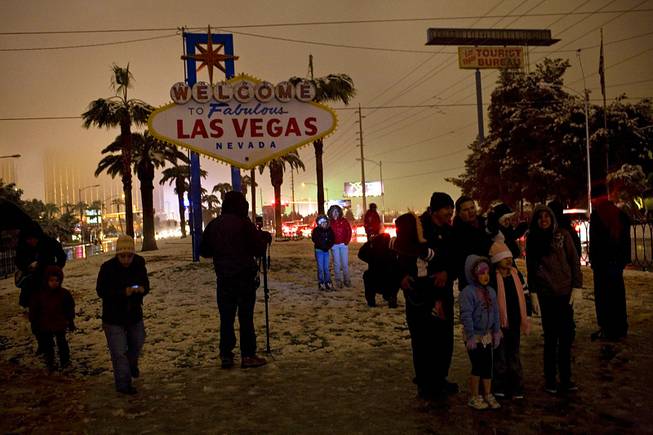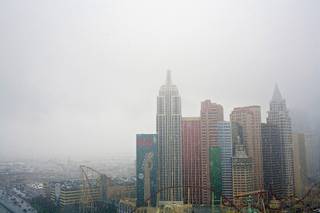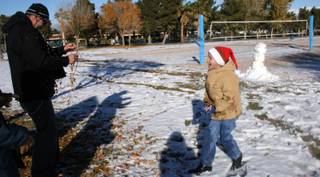
Tiffany Brown / Las Vegas Sun
Tourists and locals alike stop by the famous ‘Welcome to Las Vegas’ sign as snow continues to fall in Las Vegas on Wednesday night, Dec. 17, 2008.
Wednesday, Jan. 6, 2016 | 2 a.m.
Many people picture sun and palm trees swaying in a soft breeze when thinking about Las Vegas. But those arriving in the winter months might be surprised to find it actually gets cold here.
To be sure, snow on the ground in Las Vegas is a rarity. On average, the Las Vegas Valley gets only 0.3 inches of snowfall per year, as reported by the National Weather Service.
But despite the valley's propensity for mild winters, several snowfalls over the years have made Las Vegas feel, at least briefly, like a northern state during the winter.
Here’s a list of the valley’s biggest single-day snowfalls, plus the inevitable chaos and curiosities that followed:
1. Jan. 31 1979 — 7.4 inches
The valley’s heaviest 24-hour period of snowfall closed all 107 schools in the Clark County School District, along with UNLV and Clark County Community College.
For students who still made it to school, the temptation to throw snowballs before going home was irresistible, then-Bonanza High School Principal Scott Chalfant said. Chalfant told a Las Vegas Sun reporter he was hit “a few times” that day.
Power outages knocked two Las Vegas radio stations off the air and caused doctors at Desert Springs Hospital to limit the number of surgeries done that day.
The record snowfall also caused more than 150 traffic accidents, according to Metro Police and the Nevada Highway Patrol. The number was “unprecedented,” an NHP spokesman told the Sun.
2. Jan 12 and 25, 1949 — 4.7 inches
“Enough is enough, and we don’t want any more of this unusual weather,” claimed an unidentified Las Vegas resident in a Jan. 13, 1949, edition of the Las Vegas Evening Review-Journal.
A Jan. 26, 1949, edition of the paper estimated that the two storms, which each left 4.7 inches of snow on the ground, cost hotels, merchants and transportation companies a combined $1 million.
The weather delayed a flight carrying 5,800 baby chicks to Los Angeles from McCarran Field, as the city’s main airport was known, the report said. Also affected by the weather was a shipment of fresh Florida-cut flowers destined for Southern California florists.
3. Jan. 1, 4 and 5, 1974 — Daily average of nearly 4.5 inches
The three days combined left a record 13.4 inches of snow on the ground at the National Weather Service’s official measuring site at McCarran International Airport, producing “glasslike” road conditions and resulting in at least 24 more daily traffic crashes than a typical day, a Sun report said.
The combined snowfall was enough to produce three snow days at CCSD schools, the report said.
4. Feb. 3, 1939 — 4.0 inches
Traffic was slowed “almost to a walk” as confused Las Vegas drivers tried to avoid sliding off the road, while the city’s street vendors shoveled snow for the first time in their business careers.
On the coldest day of Las Vegas’ 1939 winter, when temperatures dropped as low as 20 degrees, the snowfall was the first ever recorded in February, according to a report from the Las Vegas Evening Review-Journal. The paper estimated the snowstorm was the largest to hit the valley since 1909.
5. Dec. 17, 2008 — 3.6 inches
Snow showers leaving as much as 8 inches on the ground in Henderson allowed CCSD students to enjoy the district's first snow day in 29 years. School sporting events, religious education classes and even a Boulder City Planning Commission meeting were also canceled that night.
Five locations in the Las Vegas Valley, normally used as cooling centers during the summer, opened as warming stations to provide shelter to those without heat.



Join the Discussion:
Check this out for a full explanation of our conversion to the LiveFyre commenting system and instructions on how to sign up for an account.
Full comments policy